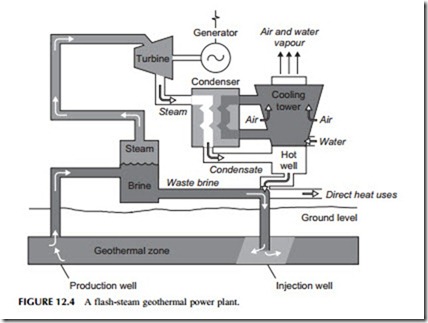FLASH STEAM PLANTS
Most high-temperature geothermal reservoirs yield a fluid that is a mixture of steam and liquid brine, both under high pressure (typically up to 10 atm). The steam content, by weight, is typically between 10% and 50%. The simplest method to exploit such a resource is to separate the steam from the liquid and use the steam alone to drive a steam turbine. This would be equivalent to the dry steam plant described earlier. However, using only the steam throws away much of the available energy, particularly where the proportion of steam in the fluid is small.
A more productive alternative is to pass the combined fluid through a valve into a vessel maintained at a lower pressure than the geothermal fluid from the reservoir (Figure 12.4). The sudden reduction in pressure “flashes” a proportion of the hot liquid to steam, creating a larger quantity of steam than was available previously. All this steam can then be separated from the liquid and used to drive a steam turbine. The steam exiting the steam turbine must be treated in exactly the same way as the exhaust from a direct steam geothermal plant to
prevent atmospheric pollution. The remaining liquid, which contains high levels of dissolved salts and presents a potential pollution problem, is usually injected back into the geothermal reservoir.
A further refinement to the flash steam plant is called double-flash technology. This involves taking the fluid remaining after the first flash process and releasing it into a second vessel at even lower pressure. Double flashing results in the production of more steam that can be fed to a second, low-pressure turbine or injected into a later stage of the turbine powered by the steam from the first flash. A double-flash plant can product up to 25% more power than a single- flash plant. However, it is more expensive and may not always be cost effective.
Flash technology plants will generally return a much higher percentage of the geothermal fluid—up to 85% for a single-flash plant and somewhat less for a double-flash plant—to the geothermal reservoir. This will include most of the dissolved chemicals contained in the original fluid. However, some reservoir depletion will still take place and without action this is likely to lead to a falloff in output from the reservoir with time. Capacities for flash geothermal power plants are normally between 20 MW and 55 MW.
